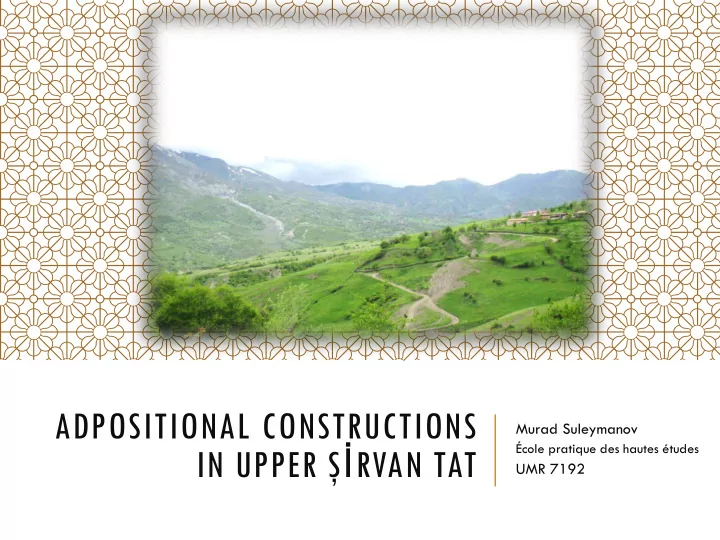

ADPOSITIONAL CONSTRUCTIONS Murad Suleymanov IN UPPER Ş İ RVAN TAT École pratique des hautes études UMR 7192
INTRODUCTION “Southwestern” Iranian language spoken mainly in Azerbaijan, also in Dagestan (Russia), Georgia, and immigrant communities (in Israel, Russia-proper, the United States, etc.) Different from Tati (a cluster of Northwestern Iranian languages spoken in Iranian Azerbaijan Number of speakers unknown; probably several tens of thousands (down from ca. 100,000 in the late 19th c.) Nominative-accusative alignment
INTRODUCTION Two main varieties: Judæo-Tat (smaller, written, well- described) and Muslim Tat (larger, non-written, under-described); little to no mutual intelligibility between them Muslim Tat is divided into four main dialect groups (limited mutual intelligibility) – Upper Şirvan Tat (UŞT) being one of them In contact with Turkic and East Caucasian, influenced heavily by Azeri (phonology, vocabulary, derivational morphology, subordinate sentence structures, etc.) All speakers are bilingual in Azeri
INTRODUCTION
ADPOSITIONS IN UPPER ŞIRVAN TAT
ADPOSITIONS IN UPPER ŞIRVAN TAT Simple and compound Why “ adpositions ”? Examples below will show that historical prepositions can be preposed and postposed to nominal dependents
SIMPLE ADPOSITIONS
SIMPLE ADPOSITIONS All have cognates in Modern Persian
SIMPLE ADPOSITIONS (1) (2) (i)
COMPOUND ADPOSITIONS
COMPOUND ADPOSITIONS Grammaticalised prepositional groups / adverbs of place (incomplete list):
COMPOUND ADPOSITIONS Can be used as adverbs in the absence of a dependent: (ii)
COMPOUND ADPOSITIONS Two strategies: ezafe oblique-marked
COMPOUND ADPOSITIONS – EZAFE Bares resemblance to the Persian ezafe structure:
COMPOUND ADPOSITIONS – EZAFE Compound adpositions preposed to their dependents: (3) (4) (5)
COMPOUND ADPOSITIONS – EZAFE Compound adpositions preposed to their dependents: (6) (iii)
COMPOUND ADPOSITIONS – OBLIQUE- MARKED Resembles the oblique possessive construction oblique marker (r)ä + possessive marker
COMPOUND ADPOSITIONS – OBLIQUE- MARKED Dependent acts as the morphological possessor: (9) (10) (11)
COMPOUND ADPOSITIONS – OBLIQUE- MARKED Dependent acts as the morphological possessor: (12)
PLACEHOLDER CONSTRUCTION
PLACEHOLDER CONSTRUCTION Term coined for Middle Persian by Jügel (to appear) an enclitic pronoun in its usual position followed by a preposition marked by a third- person ‘expletive pronoun’ the latter does not refer to an argument but instead secures the position of the fronted pronoun after the preposition (13)
PLACEHOLDER CONSTRUCTION Similar construction in UŞT third-person pronoun ü as expletive pronoun (NB. fused forms bä + ü > bö and vo / ve + ü > vö ) (14) (15) (16)
DISCUSSION 23
DISCUSSION Placeholder construction and oblique-marked construction are both dependent-final However, they are different! Placeholder construction: is only possible with the third person män=ä b ə _darun=i ‘ inside me’ *män=ä äz=män ‘ from me’ requires a personal pronoun (‘expletive’) and not a possessive clitic ħämum =a äz=ü ‘ from the bathhouse ’ * ħämum =a äz=i ‘ from the bathhouse ’
DISCUSSION Placeholder construction – relic feature of Middle Persian origin or recent development due to Turkic influence?
DISCUSSION Placeholder construction is typical only for UŞT absent in Judaeo-Tat and in all other Muslim dialects, including some UŞT -speaking villages attested in Lahıc and Əhən but notably absent in Gombori where migrants from the former two settled in the early 20 th c. THEREFORE: probably a recent development motivated by contact with Azeri, a language with no prepositions and a rich set of postpositions and case suffixes made possible by analogy with oblique-marked constructions due to constraints, simple adpositions could not be combined with possessive markers and a more typical ‘simple adposition + personal pronoun’ formula was chosen
CONCLUSION Elicitations and spontaneous corpus analysis indicate lack of substantial semantic differences between preposed and postposed constructions in Tat Similar contact-induced phenomena are attested in other Iranian languages, namely Balochi: dialects of Balochi in contact with postpositional Indo-Aryan shifted to postpositional constructions either entirely (e.g. Karachi Balochi) or partially, resulting in a parallel use of prepositions and postpositions (Farrell 2003: 196)
BIBLIOGRAPHY F ARRELL , Tim (2003). ‘Linguistic Influences on the Balochi Spoken in Karachi’. In: J AHANI , Carina & K ORN , Agnes, eds. The Baloch and Their Neighbours. Ethnic and Linguistic Contact in Balochistan in Historical and Modern Times . Reichert; pp. 169 – 210. J AHANI , Carina & K ORN , Agnes (2009). ‘Balochi’. In: W INDFUHR , Gernot, ed. The Iranian Languages . Routledge Language Family Series. Routledge; pp. 634 – 92. J ÜGEL , Thomas (to appear). ‘Enclitic Pronouns in Middle Persian and the Placeholder Construction’. In: J AAFARI -D EHAGHI , Mahmoud, ed. Professor Mansour Shaki Memorial Volume . Tehran: Center for the Great Islamic Encyclopaedia. K ORN , Agnes. ‘A partial tree of Central Iranian: A new look at Iranian subphyla’. Indogermanische Forschungen , De Gruyter, 2016, 121 (1), pp. 401-434 S TILO , Donald (2005). ‘Iranian as a Buffer Zone between Turkic and Semitic’. In: C SATÓ , Éva Ágnes et al., eds. Linguistic Convergence and Areal Diffusion. RoutledgeCurzon; pp. 35 – 63.
BĒ DIQQÄTŠ MUN QE SO Ğ BOŠ IND!
Recommend
More recommend